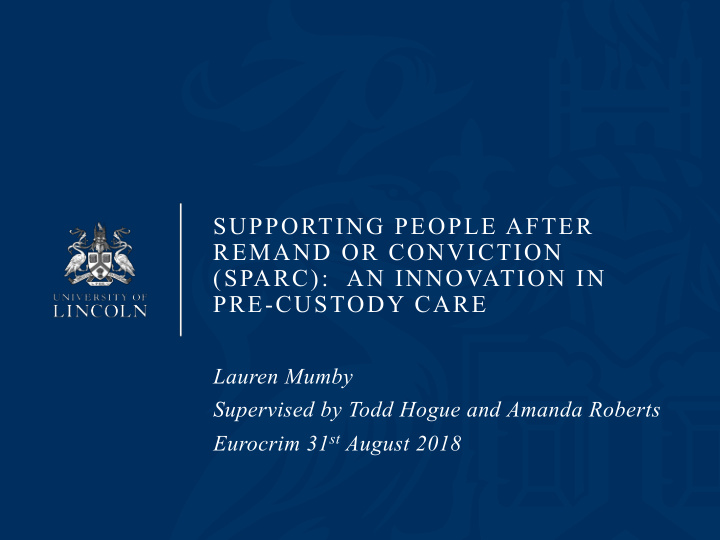



SUPPORTING PEOPLE AFTER REMAND OR CONVICTION (SPARC): AN INNOVATION IN PRE-CUSTODY CARE Lauren Mumby Supervised by Todd Hogue and Amanda Roberts Eurocrim 31 st August 2018
IMAGINE You’ve been locked in a room No belongings How would you feel? What would you need?
Presentation Plan • Prison context • The SPARC model • Theoretical background • Case example • Evaluation • Conclusion • Questions
Prison Context Early days in custody = turbulent for many • Distress and frustration resulting from the court system (Jacobson, Hunter & Kirby, 2015) • Offence Related Trauma (McNair, 2002) • Heightened risk of suicide and self harm (UK Prisons and Probation Ombudsman, 2016) • Imported vulnerabilities (Liebling, 2005) • Deprivation (Sykes, 1958; Crewe, 2011) • Family ties, accommodation, employment, finances, health (Jacobson, Edgar & Loucks, 2008). • Better support required for vulnerable people in CJS (Bradley, 2009)
The SPARC Model - Lincolnshire Action Trust Practitioners based in Court custody suites - Support to newly sentenced or remanded prisoners while in the court cells keep safe interview - Address immediate welfare needs: referrals to prison healthcare, mental health and substance misuse teams; contact families; securing pets and properties; information sharing with the prison in relation to risk and security; provide information to prisoners and their families about regime, rules and ways to keep in touch - Ongoing follow up support in the prison the day after arrival
SPARC Needs Just a few examples . . . "My children are expecting me to pick them up from school this afternoon." "I've got the bank card and my girlfriend has no money." "My boss doesn't know I'm in court - now I'll lose my job." "I'm going to prison - I'll lose my flat." "My girlfriend was crying in court - I'm so worried about her." "There's no-one to look after my cat."
Theoretical Background • Wise Intervention (Walton 2014) • Maslow’s Hierarchy of Need (1943) • Procedural Justice (Tyler, 2007) • Good Lives Model (Ward & Stewart, 2003) • Hope Theory (Snyder, 1995) • Crisis Intervention (Rogers, 2005) Miles (2015)
Theoretical background 2 • Increased wellbeing: • Dodge et al (2012) RESOURCES: RESOURCES CHALLENGES: Psychological Psychological Social Social Physical Physical P • Behavioural Nudges (Thaler & Sunstein, 2008) • Individual needs approach
Case Example DEAN • Remanded to prison – very distressed. • Needs identified during keep safe interview: statements of intent to commit suicide, depression, alcohol dependent, pet dog, tenancy • Suicide and self harm alert completed in court and handed over to reception staff, urgent mental health and substance referral – mental health substance misuse nurses met him in reception; dog located and safe – arrangements made for ongoing care; liaison with Auntie to provide information and secure tenancy, attendance at ACCT reviews. • Engagement in sentence, completion of courses and has not returned to custody
Evaluation Part 1 – Keep Safe Interviews • 1,302 interviews over a 2 year period • 1035 interviews at Magistrates Court, 267 Crown • 1093 different people (209 people were seen more than once*) • Needs: 46% physical health, 43% mental health, 16% suicide and self-harm concerns, 50% substance misuse concerns, 14% learning need, 15% language needs, 27% security concerns, 54% immediate concerns • History: 20% no GP, 46% no mental health support, 54% no substance misuse support, 59% substance misuse related to offending • Activity: 328 physical health referrals, 491 substance misuse referrals, 443 mental health referrals, 177 suicide alerts, 295 security alerts, 175 families contacted, 31 pets secured, 14 safeguarding referrals made. *2 nd appearances excluded from needs and history data
Evaluation Part 2 – Safer Custody Surveys • 289 respondents, volunteers within local prison served by SPARC • SPARC (N=71) vs Non-SPARC (N=218) no significant differences in demographics of 2 groups • 87.3% found SPARC helpful. Helpful across all age groups, whether previous custody experiences and residential location • SPARC clients scored significantly more positively on Clinical Outcomes Routine Evaluation (CORE; Evans et al, 2002) than non- SPARC • SPARC clients scored significantly more positively on the wellbeing, functioning and problems subscales of the CORE • Less feelings of panic, terror, despair, hopelessness, tension, anxiety and isolation; more feelings of being happy and being able to do things they needed to.
Evaluation Part 3- Focus groups • 11 participants across vulnerable prisoner and ‘main’ populations. • Positive feelings e.g. reassurance, calming • Support ‘outside the system’ • Better prepared for prison • Support with practicalities & impact on release • Help for families • SPARC as a quality service (e.g. accountability and action planning • Immediacy and continuity
Conclusion • SPARC is a Wise Intervention which aims to support people during their transition into custody though a series of behavioural nudges unique to each individual, embedded within theoretical underpinnings from Maslow’s Hierarchy of Needs, Procedural Justice and the Good Lives Model • SPARC works to decrease challenges while increasing resources • SPARC provides an opportunity to monitor the needs of people at the specific point of entry into prison custody from court • SPARC clients display higher levels of wellbeing than those who do not receive the intervention • Further research is required to ascertain long term impact.
QUESTIONS Thank you
Recommend
More recommend